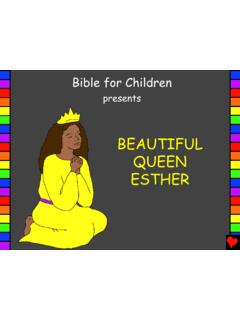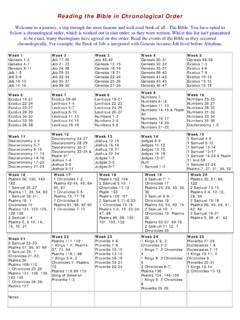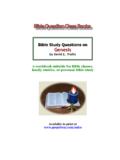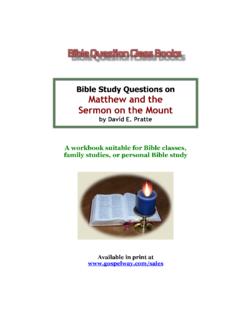Transcription of Student’s Book 6 - Macmillan Caribbean eBooks
1 Student s book 6 Second EditionMacmillan Education4 Crinan StreetLondon, N1 9 XWA division of Macmillan Publishers LimitedCompanies and representatives throughout the Text Leonie Bennett 2016 Design and illustration Macmillan Publishers Limited 2016 The author has asserted her rights to be identified as the author of this work in accordance with the Copyright, Design and Patents Act 1988 This edition published 2016 First edition published 2006 All rights reserved; no part of this publication may be reproduced, stored in a retrieval system, transmitted in any form, or by any means, electronic, mechanical, photocopying, recording, or otherwise, without the prior written permission of the by Macmillan Education and Blue Dog Design Studio Illustrated by Annabelle Spenceley c/o Advocate Art; Jim Eldridge and Jan Smith c/o Beehive; Pam Goodchild and Joanna Williams c/o Kearley; Monica Auriemma, Dave Hill, Bethan Matthews and Andrew Painter c/o Sylvie Poggio; Tek-ArtCover design by Macmillan Education and Clare WebberCover illustration by Nathalie GavetTypeset by Tek-ArtThe author and publishers would like to thank the following education professionals for their valuable contributions to this edition: Suzette Abbott-King (St Vincent), Leonie Alexander-Charles (St Vincent), Ingrid Daniel-Simon (Antigua), Janelle Little (Barbados), Tessa McQuilkin (Grenada), Christina Morris (Barbados), Rochelle Richards (Antigua), Edwina Riviere (Dominica), Carla St.
2 Louis (Grenada) and Sandra Thomas (Grenada)The authors and publishers would like to thank the following for permission to reproduce their photographs:Alamy/John Anderson p39, Alamy/Laura Romin & Larry Dalton p115, Alamy/Robert Harding p65, Alamy/Martin Harvey p66, Alamy/David Pick p41, Alamy/Rolf Richardson p48: Corbis/John Harper p56, Corbis/Radius Images p83; Getty Images/AFP p51, Getty Images/ Michael & Patricia Fogden p145, Getty Images/Fuse p27, Getty Images/Mike Hewitt p53, Getty Images/Brian Skerry p38, Getty Images/Cameron Spencer p50; Macmillan Publishers Ltd p35; Nature Picture Library/Claudio Contreras p43, Nature Picture Library/Jurgen Freund p116, Nature Picture Library/Klein and Hubert p68, Nature Picture Library/Barry Mansel p118, Nature Picture Library/Alex Mustard p37; Rex Features/Daily Mail/Ted Blackbrow p128, Rex features/Back Page Images p52, Rex Features/BILL ZYGMANT p122; Shutterstock/Umkehrer covers reproduced by permission:Bright Sparks: Caribbean Primary Mathematics 6 by Laurie Sealy and Sandra Moore, published by Macmillan Caribbean , cover image used with and Family Life Education Student book 5, published by Macmillan Caribbean , cover image used with of the Caribbean - A Diver s Guide by Martha Watkins Gilkes, published by Macmillan Caribbean , cover image used with permission.
3 Sketches of Amerindian Tribes by Edward A. Goodall, published by Macmillan Caribbean , cover image used with permission. Wild Plants of Barbados by Sean Carrington, published by published by Macmillan Caribbean , cover image used with permission. The author and publisher would like to thank the following for permission to reproduce the following material. Aximu s Awakening by Pamela Mordecai. Printed with permission of the Guy Rap by Tony Mitton. Printed with permission of David Higham Literacy Agency on behalf of the re Tigre and the Princess from De Red Petticoat by esther O Neale. Printed with permission of the from The Complete Poems of Randall Jarrell by Randall Jarrell. Printed with permission of Farrar, Straus and Giroux, LLC on behalf of the author s materials may contain links for third party websites. We have no control over, and are not responsible for, the contents of such third party websites.
4 Please use care when accessing 978-1-380-00830-5 AERC ontentsHow to Use this book 4 Scope and Sequence 6 Unit 1 The Shield of Kindness .. 8 Unit 2 Co-operation .. 15 Unit 3 Super-kit .. 22 Unit 4 Aximu s Awakening .. 29 Unit 5 West Indian Manatees .. 36 Unit 6 Rainforest Trip .. 44 Looking Back 1 50 Unit 7 The Calm of the Evening .. 57 Unit 8 Birthday Outing .. 64 Unit 9 Stay Safe Online .. 71 Unit 10 In Business .. 78 Unit 11 Greedy Guy Rap .. 86 Unit 12 How to Make a Carnival Headdress .. 93 Looking Back 2 101 Unit 13 A Challenging Life Story .. 108 Unit 14 Bats .. 115 Unit 15 Jennifer Hosten .. 122 Unit 16 A Cow Called Boy .. 129 Unit 17 Support Our Library .. 137 Unit 18 Climate Change Wipes Out Frogs .. 145 Looking Back 3 152 The Writing Process 159 Sample Compositions 160 Glossary 166 Skills Index 167storyplayadvertisementspoemexpository textchronological reportdescriptioninformal letterexpository and websitestorypoeminstructionsnarrativeexp ository and poembiographyextract from novelformal letterexpository454 How to Use this BookLanguage tree Level 6 components are designed to be used flexibly, in line with the teacher s preferred approach and the ability of the class.
5 The Student s book is intended to be used alongside the Workbook and online Teacher s Resources ( ) to help students to develop and practise important reading, listening, speaking and comprehension skills. Teaching units There are 18 teaching units, each of which comprises the following sections:Get readyThe teacher leads a class discussion which introduces the reading passage and draws on the students prior knowledge and experience. The teacher can take this opportunity to draw students attention to the type of text (fiction, non-fiction, poetry, etc.) and to introduce key vocabulary. ReadingThe passages cover a variety of different text types which can be read silently or by students taking it in turn to read a section. Encourage students to work out the meaning of unfamiliar vocabulary from the questions ask students to recall detail, make inferences, draw conclusions, identify cause and effect and express personal opinions.
6 Some questions draw students attention to the features of the text type, pointing out, for example, the differences between information texts and stories or questions can be tackled orally or in writing depending on the needs of the class. For most classes it will be appropriate to talk through the questions before asking students to write answers. 3636 Get readyWhat do you know about manatees?What would you like to know? Think of three a KWL chart like this one and fill in the first two I knowWhat I want to knowWhat I have learntReadingRead the passage to see if it answers your 5 West Indian ManateesComprehension strategyDevelopment of ideasWest Indian ManateesManatees are aquatic mammals, related to the elephant. They are fascinating creatures. It is said that manatees have often been mistaken for mermaids, although it is hard to imagine how this can be.
7 Manatees have rough, grey-brown, bristly skin and thick whiskers, whereas mermaids are said to be beautiful young women. Manatees look more like seals than mermaids. Manatees are herbivores, which means they only eat plants usually sea grass. They are also called sea-cows and, like cows, they spend a lot of time eating vegetation. They eat up to 15 per cent of their body weight a day which is rather like you eating 200 heads of lettuce!Manatees spend their days eating, resting and travelling as well as playing with other manatees. They are very agile creatures and play with other manatees by rolling, performing somersaults and body surfing. Manatees don t sleep for long periods like we do. Instead, they take short naps throughout the day and night. They have no natural predators so it is safe for them to sleep on the sea floor but they can t stay there long as they have to surface to water-loving mammals breathe through their nostrils.
8 They normally come to the surface to breathe every three to five minutes. When very active, however, they surface as often as every 30 seconds. Their nostrils close up when they are underwater. Manatees have been known to stay underwater for 15 to 20 minutes when they are Make a KWL chart by creating a three-column Indianmanateehabitat The KWL chart is a useful comprehension strategy. Use it with a range of expository texts to help students to develop the skills of summarising text. It is also useful for getting students to construct questions. Help students to develop a range of comprehension strategies in relation to all of their reading, such as drawing conclusions, making inferences, identifying main ideas and observing cause and and listening The symbol before an exercise advises students to work with a exercises involve discussion, others suggest retelling or role plays.
9 Move around the class, checking on progress or work alongside those students who find oral work most 7 Descriptive textWB 6 p00A descriptive text describes places, objects or scenes and creates a picture in the mind of the reader. To do this, the writer uses words and phrases which appeal to the descriptive writing also uses figurative language such as simile and Answer these questions about paragraph 1 of the story. 1 What did Melissa feel? 2 What did she smell? 3 What did she hear?4 What did she see?5 Find one In paragraph 2, find five adjectives which describe the smell of different kinds of Find a metaphor in paragraph and listening: description1 Think of a place you visit often. It may be inside or outside; somewhere you like or somewhere you don t like. 2 Describe the place to your partner. Say what you see, hear, smell and feel there.
10 3 Listen to your partner s description. 4 Ask your partner two questions about the place he or she has : continuous tensesDA language , Exercise 1: Work with some students to distinguish between present and past continuous in the story. The first page of the story is told in the past tense and contains past continuous verbs. The dialogue on page 58 includes verbs in the present continuous. You may wish to tell students that a helping verb + a main verb is a verb phrase, he is sleeping. The underlined phrase is a verb present continuous tense tells us what is happening form this tense we use the helping verbs am / is / are with the present participle of the main verb. The present participle is formed by adding -ing to the verb. helping verb main verbHe is still Find four verbs in the present continuous tense in the second part of the story on page is an important part of a story.












